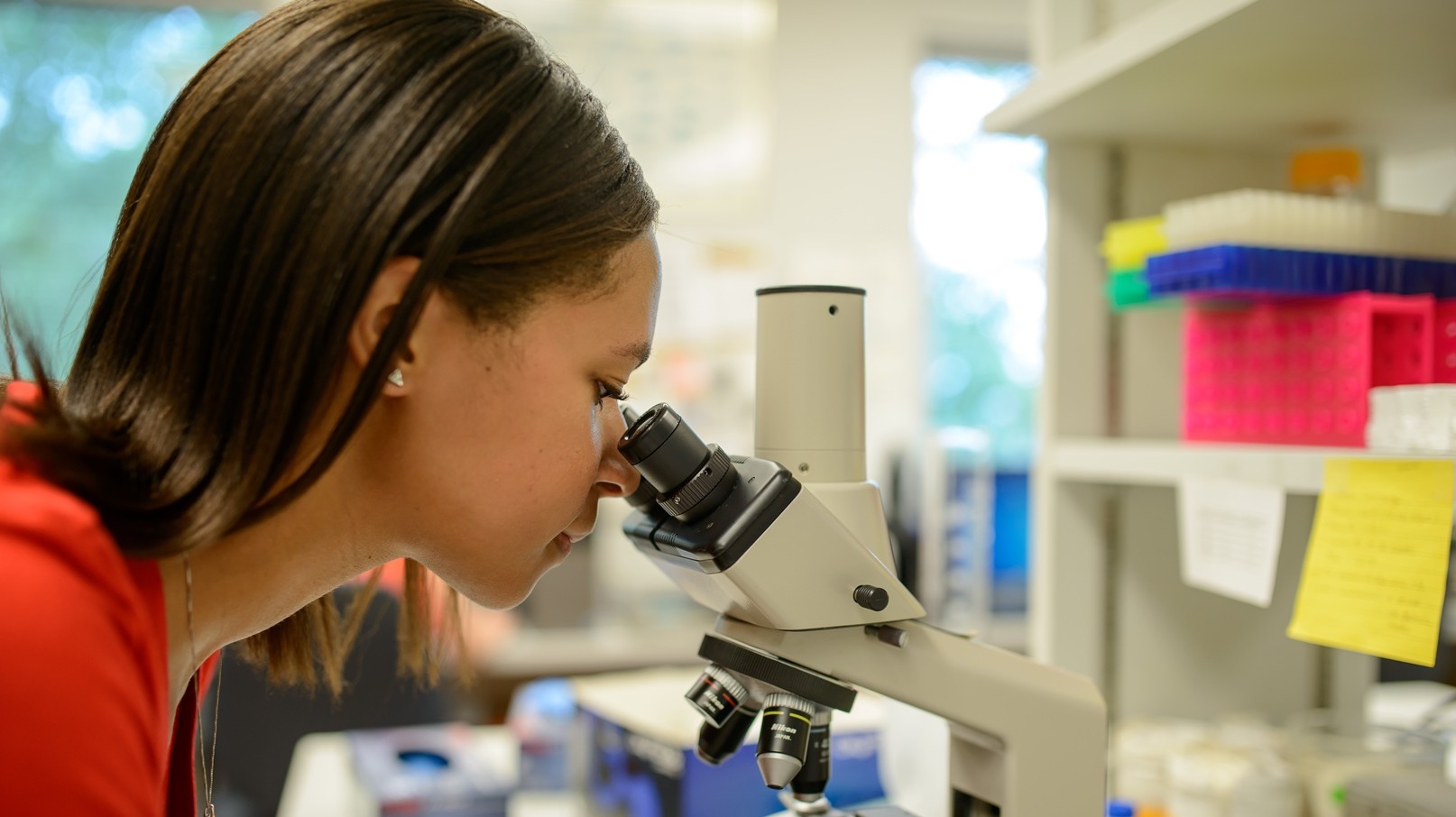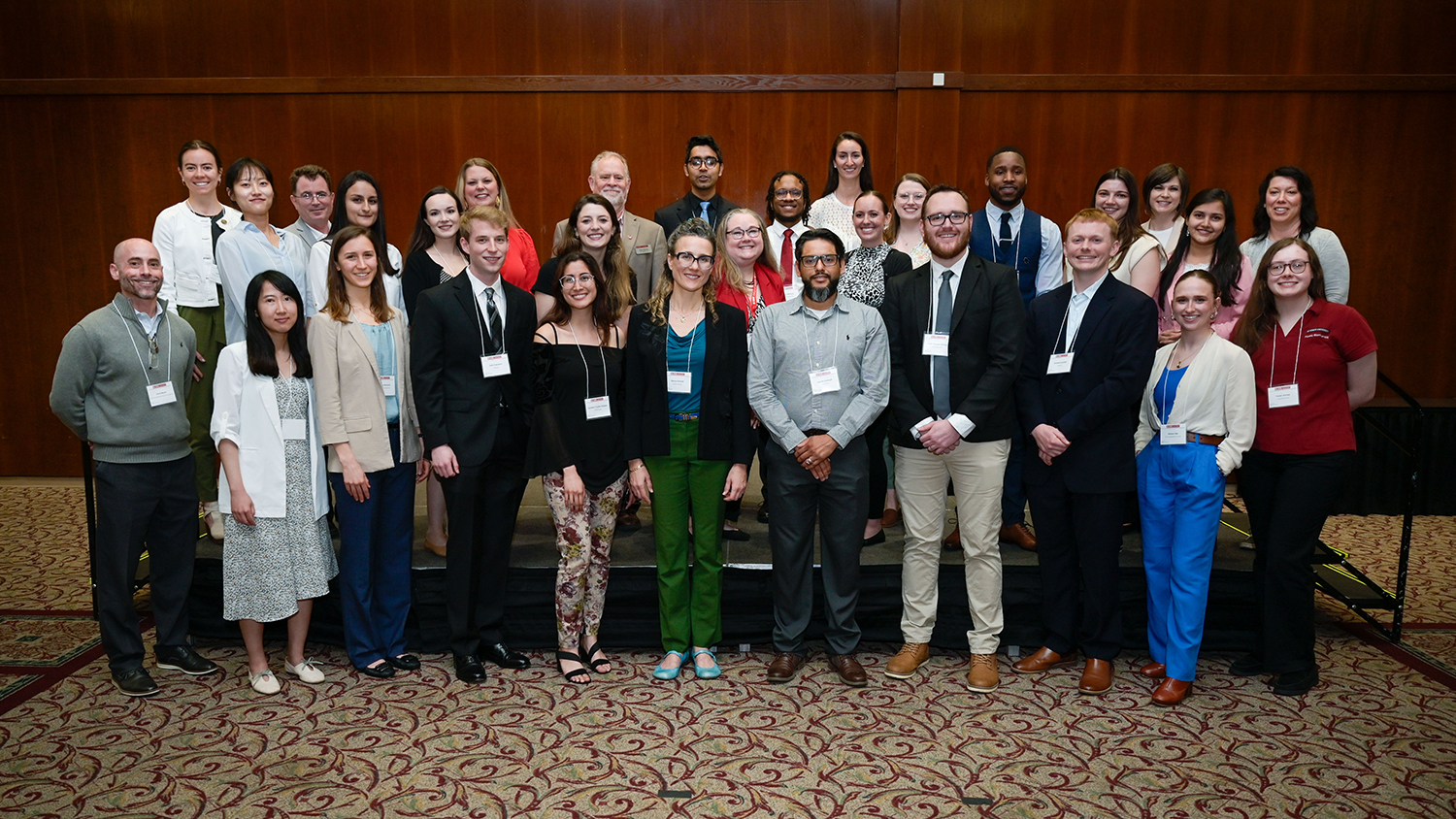Student Investigates: Are Chemicals Making You Fat?

NC State University toxicology Ph.D. student Charisse Holmes has been interested in health and science since her undergraduate days studying chemistry. Given what she now investigates—that adverse health triggers can occur in ubiquitous consumer products—she is encouraged to note that the public is more interested and engaged in those same things.
“I think in general, society is getting a little better about being informed and staying on top of what we are exposed to,” Holmes says, using the example of a simple water bottle on the table before her. “Now, you see things on water bottles about BPA. Even though I’m 26, I knew there wasn’t as much stressed about that in the past.”
Water bottles were only one indication of an increasing public interest concerning safer consumer products. Bisphenol A, commonly known as BPA, has been used since the 1950s in many household products, including baby bottles. Known to be an endocrine disrupter, BPA is now banned from certain products.
As a toxicologist, Holmes doesn’t duck the big issues facing health and science, such as cancer-causing compounds. In fact, she continues doing what she has since a teenager with a gift for science: she dove in head-first, immersing herself in her work, while also investing herself in her community.
Early Days as a Researcher
Holmes first became interested in cancer research while still a Wake Forest University undergraduate.
“I performed experiments for advisor Mark Welker, chemically synthesizing a uniquely designed prostate cancer-specific PL 3-kinase inhibitor,” she said. Prostate cancers rely upon signaling for their survival and growth. The family of enzymes the inhibitor belonged to perform various cellular functions, some of which were involved in cancers.
After completing her undergraduate degree, Holmes transitioned for a year to a breast cancer project at Wake Forest Medical Center. “We predicted that muscadine grade seeds and muscadine grape skin extracts could inhibit breast cancer. We tested this hypothesis using breast cancer cells and nude mice,” Holmes said.
“I also worked with Mark Espeland on a clinical trial project called LOOK AHEAD and analyzed data using SAS software.”
Fast forward only a few years. Holmes, a Delaware native, remained in North Carolina and applied to Graduate School at NC State. She had her sights on earning a doctorate in biological science.
Now Holmes is age 26, working under research professor Gerald A. LeBlanc, director of the toxicology program at NC State. She remains fascinated by adding to the knowledge base about how better science can make us healthier.
“After acquiring those research experiences, I picked Jerry LeBlanc’s lab because I thought he was a great guy and his lab seemed like it would be a great fit for me. He was interested in chemical mixtures, nuclear receptor signaling pathways pertaining to human health, and metabolic disorders such as weight gain and diabetes,” she explains. “Basically, it’s a blend of my interests and topics that I had worked on in the past.”
LeBlanc’s research work in metabolic syndrome is a familiar media topic. It is a serious medical condition frequently discussed on healthcare websites and in physicians’ offices. According to LeBlanc, the condition is now endemic in the United States.
“A lot of people define metabolic differently,” says Holmes. “Typically, it involves weight gain, cardiovascular disease and type 2 diabetes.”
Metabolic Syndrome: A Growing Problem with Endemic Numbers
Metabolic syndrome is a prevalent medical condition earmarked by the presence of several indicators (e.g., high blood sugar levels, excess abdominal fat, and/or high blood pressure) that become far more serious when they occur together. As a cluster of conditions, metabolic syndrome signals an increased risk of stroke, diabetes and heart disease, warn sources such as the Mayo Clinic.
The warning becomes more serious, considering that such a significant percentage of American adults have metabolic syndrome. It also casts a wide net, even affecting children. Holmes confirms that an estimated 20-30 percent of the population is affected by metabolic syndrome.
Meanwhile, LeBlanc is working towards establishing whether a correlation exists between metabolic syndrome and certain chemicals—at a lower threshold than previously understood.
LeBlanc writes in an email, “Epidemiological studies suggest a linkage between exposure to some environmental chemicals and metabolic syndrome. However, lab studies generally indicate that exposure concentrations of chemicals required to cause metabolic syndrome are much greater than what humans are typically exposed to.”
According to LeBlanc, Holmes’ research concerns the possibility “that low, environmentally relevant levels of some chemicals, in combination, act synergistically to perturb lipid and glucose homeostasis resulting in metabolic syndrome.”
Those chemicals are frequently used in household products such as flea preventatives for pets and even commonly used cosmetics such nail polishes.
“Our lab is also looking at the chemical triphenyl phosphate,” explains Holmes. “Triphenyl phosphate is in nail polish, plastics, furniture and household dust.” She asks, “Is it safe, or isn’t it?”
Holmes says it is known that certain compounds (such as triphenyl phosphates) can inhibit receptors that reduce weight gain. “Such compounds stimulate receptors that are responsible for weight gain,” she adds. “I know it can reduce bone strength.” There may be other issues, such as implications of the length of exposure. There may be a connection between leaving nail polish on too long, she adds.
How can this be tested? “Generally, scientist do thoroughly screen chemicals using cells and cellular- based assays first,” Holmes says. “Then if the chemical appears to have an adverse effect, they screen the chemicals using animal models, which can include water fleas, fish, rodents and pigs. Typically, rabbits, guinea pigs and pigs are used for cosmetic screenings.”
Connecting with the Community Through Volunteerism

Now in her fourth year at NC State, Holmes is on track to complete her doctorate in 2017. Meanwhile, she works to maintain a healthy lifestyle balance of her own outside the lab. She stays fit by running in the afternoons with Rudy, a golden retriever/corgi mix, and sometimes brings the very well-behaved Rudy to the lab for a visit. “There are a lot of dog lovers in my department,” she confides.
She also takes her four-footed pal on much more serious forays. Holmes volunteers at the Wake Medical Center near the NC State campus, where Rudy also volunteers as a trained therapy dog. The hospital volunteer gig requires the 5-year-old canine to periodically submit to assessments which determine his sociability and responsiveness.
“He had to know basic commands,” she says. “I had to take him for interviews, and see a behavioral expert. They subject him to tests every six months.”
He handles it like the pro he is, says a proud Holmes. Rudy, like his mistress, is an ace student and passes the tests with flying colors. He proudly wears his volunteer badge while on the job, one he has earned by mastering skills the work requires.
“Rudy has been doing this work for almost two years. He generally is involved Wednesday nights. He has been part of the hospitality pet program for one and a half years. Rudy has certain floors we’re allowed on. He visits the patients, and they pet him and share stories.”
Volunteering is something her parents, Beverly and Ronnie, encouraged. “Growing up, my Mom emphasized volunteering, and l always wanted to do that. I could spare two hours of a day,” she says.
Holmes helps assist and comfort families at the front desk in the Emergency Room. It is humanizing work; hours spent at the hospital connect Holmes to the very people whom her research may affect and hopefully benefit in the near future.
Read more about Charisse Holmes’ research and what to look for in cosmetics and toiletries.
Cynthia Adams is a feature writer, columnist, and editor based in Greensboro, N.C.
- Categories:


